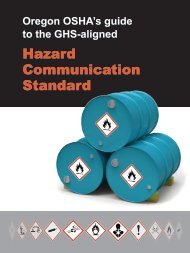Technical Manual - Section 3 (Safety Hazards)
Technical Manual - Section 3 (Safety Hazards)
Technical Manual - Section 3 (Safety Hazards)
You also want an ePaper? Increase the reach of your titles
YUMPU automatically turns print PDFs into web optimized ePapers that Google loves.
minerals and dissolved impurities that can damage the system<br />
or affect its operation. Suspended materials such as silt,<br />
sewage, and oil, which form scale and sludge, must be<br />
coagulated or filtered out of the water. Dissolved gases,<br />
particularly carbon dioxide and oxygen, cause boiler<br />
corrosion and are removed by deaeration and treatment.<br />
Dissolved minerals including metallic salts, calcium,<br />
carbonates, etc., that cause scale, corrosion, and turbine blade<br />
deposits are treated with lime or soda ash to precipitate them<br />
from the water. Recirculated cooling water must also be<br />
treated for hydrocarbons and other contaminants.<br />
Depending on the characteristics of raw boiler feedwater,<br />
some or all of the following six stages of treatment will be<br />
applicable:<br />
(1) Clarification<br />
(2) Sedimentation<br />
(3) Filtration<br />
(4) Ion exchange<br />
(5) Deaeration<br />
(6) Internal treatment<br />
HEALTH AND SAFETY CONSIDERATIONS<br />
Fire Protection and Prevention<br />
The most potentially hazardous operation in steam generation<br />
is heater startup. A flammable mixture of gas and air can<br />
build up as a result of loss of flame at one or more burners<br />
during light-off. Each type of unit requires specific startup<br />
and emergency procedures including purging before lightoff<br />
and in the event of misfire or loss of burner flame.<br />
<strong>Safety</strong><br />
If feedwater runs low and boilers are dry, the tubes will<br />
overheat and fail. Conversely, excess water will be carried<br />
over into the steam distribution system and damage the<br />
turbines. Feedwater must be free of contaminants that could<br />
affect operations. Boilers should have continuous or<br />
intermittent blowdown systems to remove water from steam<br />
drums and limit buildup of<br />
scale on turbine blades and superheater tubes. Care must be<br />
taken not to overheat the superheater during startup and<br />
shut-down. Alternate fuel sources should be provided in the<br />
event of loss of gas due to refinery unit shutdown or<br />
emergency. Knockout pots provided at process units remove<br />
liquids from fuel gas before burning.<br />
Health<br />
Safe work practices and/or appropriate personal protective<br />
equipment may be needed for potential exposures to<br />
feedwater chemicals, steam, hot water, radiant heat, and<br />
noise, and during process sampling, inspection, maintenance,<br />
and turnaround activities.<br />
PRESSURE-RELIEF AND FLARE SYSTEMS<br />
PRESSURE-RELIEF SYSTEMS<br />
Pressure-relief systems control vapors and liquids that are<br />
released by pressure-relieving devices and blow-downs.<br />
Pressure relief is an automatic, planned release when<br />
operating pressure reaches a predetermined level. Blowdown<br />
normally refers to the intentional release of material, such as<br />
blowdowns from process unit startups, furnace blowdowns,<br />
shutdowns, and emergencies. Vapor depressuring is the rapid<br />
removal of vapors from pressure vessels in case of fire. This<br />
may be accom-plished by the use of a rupture disc, usually set<br />
at a higher pressure than the relief valve.<br />
SAFETY RELIEF VALVE OPERATIONS<br />
<strong>Safety</strong> relief valves, used for air, steam, and gas as well as for<br />
vapor and liquid, allow the valve to open in proportion to the<br />
increase in pressure over the normal operating pressure.<br />
<strong>Safety</strong> valves designed primarily to release high volumes of<br />
steam usually pop open to full capacity. The overpressure<br />
needed to open liquid-relief valves where large-volume<br />
discharge is not required increases as the valve lifts due to<br />
increased spring resistance. Pilot-operated safety relief valves,<br />
with up to six times the capacity of normal relief valves, are<br />
used where tighter<br />
III:2-51
















